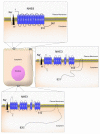The Physiological Function and Potential Role of the Ubiquitous Na+/H+ Exchanger Isoform 8 (NHE8): An Overview Data
- PMID: 36142772
- PMCID: PMC9501935
- DOI: 10.3390/ijms231810857
The Physiological Function and Potential Role of the Ubiquitous Na+/H+ Exchanger Isoform 8 (NHE8): An Overview Data
Abstract
The Na+/H+ exchanger transporters (NHE) play an important role in various biologic processes including Na+ absorption, intracellular pH homeostasis, cell volume regulation, proliferation, and apoptosis. The wide expression pattern and cellular localization of NHEs make these proteins pivotal players in virtually all human tissues and organs. In addition, recent studies suggest that NHEs may be one of the primeval transport protein forms in the history of life. Among the different isoforms, the most well-characterized NHEs are the Na+/H+ exchanger isoform 1 (NHE1) and Na+/H+ exchanger isoform 3 (NHE3). However, Na+/H+ exchanger isoform 8 (NHE8) has been receiving attention based on its recent discoveries in the gastrointestinal tract. In this review, we will discuss what is known about the physiological function and potential role of NHE8 in the main organ systems, including useful overviews that could inspire new studies on this multifaceted protein.
Keywords: NHE8; eyes; gastrointestinal tract; kidney; lungs; testis.
Conflict of interest statement
The authors declare no conflict of interest.
Figures


Similar articles
-
Na+/H+ Exchangers (NHEs) in Mammalian Sperm: Essential Contributors to Male Fertility.Int J Mol Sci. 2023 Oct 7;24(19):14981. doi: 10.3390/ijms241914981. Int J Mol Sci. 2023. PMID: 37834431 Free PMC article. Review.
-
Gastrointestinal distribution and kinetic characterization of the sodium-hydrogen exchanger isoform 8 (NHE8).Cell Physiol Biochem. 2008;21(1-3):109-16. doi: 10.1159/000113752. Epub 2008 Jan 16. Cell Physiol Biochem. 2008. PMID: 18209477
-
Renal expression of novel Na+/H+ exchanger isoform NHE8.Am J Physiol Renal Physiol. 2003 Mar;284(3):F467-73. doi: 10.1152/ajprenal.00352.2002. Epub 2002 Oct 29. Am J Physiol Renal Physiol. 2003. PMID: 12409279
-
Proximal tubule Na+/H+ exchanger activity in adult NHE8-/-, NHE3-/-, and NHE3-/-/NHE8-/- mice.Am J Physiol Renal Physiol. 2012 Dec 1;303(11):F1495-502. doi: 10.1152/ajprenal.00415.2012. Epub 2012 Oct 10. Am J Physiol Renal Physiol. 2012. PMID: 23054255 Free PMC article.
-
Na(+)/H(+)exchangers: linking osmotic dysequilibrium to modified cell function.Cell Physiol Biochem. 2001;11(1):1-18. doi: 10.1159/000047787. Cell Physiol Biochem. 2001. PMID: 11275678 Review.
Cited by
-
Cytosolic and Acrosomal pH Regulation in Mammalian Sperm.Cells. 2024 May 17;13(10):865. doi: 10.3390/cells13100865. Cells. 2024. PMID: 38786087 Free PMC article. Review.
-
Na+/H+ Exchangers (NHEs) in Mammalian Sperm: Essential Contributors to Male Fertility.Int J Mol Sci. 2023 Oct 7;24(19):14981. doi: 10.3390/ijms241914981. Int J Mol Sci. 2023. PMID: 37834431 Free PMC article. Review.
-
The Role of Ion-Transporting Proteins in Human Disease.Int J Mol Sci. 2024 Jan 31;25(3):1726. doi: 10.3390/ijms25031726. Int J Mol Sci. 2024. PMID: 38339004 Free PMC article.
-
Jian-Pi-Yin decoction attenuates lactose-induced chronic diarrhea in rats by regulating GLP-1 and reducing NHE3 ubiquitination and phosphorylation.Heliyon. 2023 Jun 30;9(7):e17444. doi: 10.1016/j.heliyon.2023.e17444. eCollection 2023 Jul. Heliyon. 2023. PMID: 37539150 Free PMC article.
-
Human Colonoid-Myofibroblast Coculture for Study of Apical Na+/H+ Exchangers of the Lower Cryptal Neck Region.Int J Mol Sci. 2023 Feb 21;24(5):4266. doi: 10.3390/ijms24054266. Int J Mol Sci. 2023. PMID: 36901695 Free PMC article.
References
Publication types
MeSH terms
Substances
Grants and funding
LinkOut - more resources
Full Text Sources
Miscellaneous

